A FitLot Circuit Training Session is a 60-minute workout consisting of 1-3 rounds of 12-24 different exercise stations providing a full body workout. It is designed to improve cardiovascular fitness, increase muscular strength and endurance, and improve overall mobility and flexibility. Participants begin each session with a warm up, spend between 30-60 seconds at each station of the circuit depending on the class design and objective, and end each session with a cool down, including stretching and mobility work.
Fundamental Movements
FitLot provides a hub for a variety of training preferences utilizing progressive resistance and personal body weight. In addition, it is a platform for training methods such as Circuit Training, Pilates, Yoga, TRX, Calisthenics, CrossFit and more. While not exhaustive, below is a list of fundamental movements that can be a great foundation for FitLot classes. Mastering these movements and understanding how to modify and progress each one to accommodate various fitness levels will help trainers coach participants with differing skills and abilities. With a strong grasp of the basics, a trainer is then able to be more creative and thoughtful with each new class.
Simple and effective strategies of modifying most movements
To Regress… |
To Progress… |
|
|
Fundamental Movement Guide
Crunch/Roll up
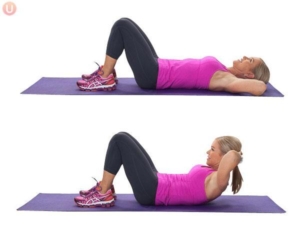
Preparation: Lie on your back (supine position) with knees bent. Place hands behind the head with the elbows pointing outward.
Execution: Curl torso keeping the chin tilted upward and hands held lightly behind the head. Return to original position. Exhale moving up, on exertion. Inhale moving down.
Comments: Keep the eyes up and avoid driving the chin toward the chest or pulling on the back of the head.
Back Extension

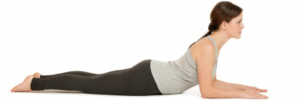 Preparation: Lie in a prone position, and extend your legs keeping your heels together. Place the back of your hands under your chin or your forehead, elbows pointing outward.
Preparation: Lie in a prone position, and extend your legs keeping your heels together. Place the back of your hands under your chin or your forehead, elbows pointing outward.
Execution: Lift your upper back pressing your hips down, allowing your head, hands and chest to rise. Inhale moving up, on exertion. Exhale moving down.
Comments: Keep your head and neck neutral. Maintain a steady pace through both the downward and upward phase of the movement. (No momentum).
Push up
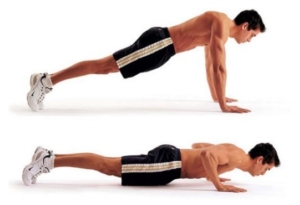 Preparation: Assume a high plank position, hands on the floor underneath your chest, feet flexed in line with the hips. Squeeze your thighs and glutes for stability. Engage your core.
Preparation: Assume a high plank position, hands on the floor underneath your chest, feet flexed in line with the hips. Squeeze your thighs and glutes for stability. Engage your core.
Execution: While keeping body straight, gradually lower body to floor by flexing arms. When elbows are aligned with shoulders, gradually push up. Inhale to lower the body. Exhale moving up on exertion.
Comments: Both upper and lower body must be kept straight throughout the movement. Keep your head and neck neutral. Maintain a steady pace through both the downward and upward phase of the movement. (No momentum).
Squat
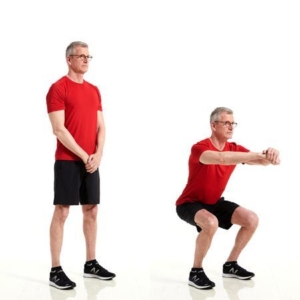 Preparation: Stand upright, feet parallel, shoulder width apart, knees pointing and in line with the big toe. Heels flat on the floor. Arms extended forward. Abs engaged, lower back arch maintained, chin balanced, look straight ahead.
Preparation: Stand upright, feet parallel, shoulder width apart, knees pointing and in line with the big toe. Heels flat on the floor. Arms extended forward. Abs engaged, lower back arch maintained, chin balanced, look straight ahead.
Execution: Flex knees and hips until the thighs are parallel to the floor. Inhale going down. Return to the upward position. Exhale on exertion, going up.
Comments: Maintain a rigid core and a straight back throughout the movement. Knees should not go forward past the toes. Maintain a steady pace through both the downward and upward phase of the movement. (No momentum).
Static Lunge/Split Squat
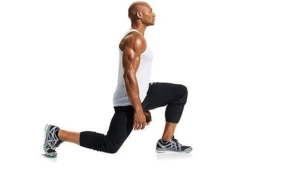 Preparation: Stand upright, feet parallel. Take one step forward flexing the knees and the hips until the rear leg knee almost touches the floor. The rear knee is under the shoulder, the front knee doesn’t exceed the toes of the lead foot.
Preparation: Stand upright, feet parallel. Take one step forward flexing the knees and the hips until the rear leg knee almost touches the floor. The rear knee is under the shoulder, the front knee doesn’t exceed the toes of the lead foot.
Execution: Return to the original upright position. Exhale on exertion, going up. Inhale moving down.
Comments: Keep the chest up, core tight, shoulders retracted. Maintain a steady pace through both the downward and upward phase of the movement. (No momentum).
Arm Curl
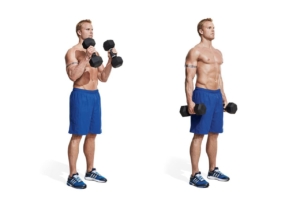 Preparation: Stand upright, feet parallel, shoulder width apart. Core engaged, knees not locked. Hold on to the barbell, dumbbell, or resistance band handles. Arms extended, palms facing up, elbows next to and slightly ahead of your body.
Preparation: Stand upright, feet parallel, shoulder width apart. Core engaged, knees not locked. Hold on to the barbell, dumbbell, or resistance band handles. Arms extended, palms facing up, elbows next to and slightly ahead of your body.
Execution: Keeping elbows stable, flex your arm to bring your palms toward your shoulders. Exhale moving up, on exertion. Inhale moving down.
Comments: Keep chest up, shoulders retracted, don’t lean back. Maintain a steady pace through both the downward and upward phase of the movement. (No momentum).
Triceps Extension
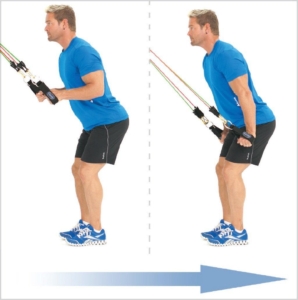 Preparation: Standing upright with the torso straight, bring the upper arms close to your body and perpendicular to the floor, elbows next and slightly ahead of the body. The forearms should be pointing towards the apparatus as they hold the bar(handles).
Preparation: Standing upright with the torso straight, bring the upper arms close to your body and perpendicular to the floor, elbows next and slightly ahead of the body. The forearms should be pointing towards the apparatus as they hold the bar(handles).
Execution: Gradually lower your forearms until arms are fully extended perpendicular to the floor. The upper arms should always remain stationary next to your torso and only the forearms should move. Exhale moving down, on exertion. Inhale moving up.
Comments: Keep chest up, shoulders retracted. Core engaged. Maintain a steady pace through both the downward and upward phase of the movement. (No momentum)
Heel Raise
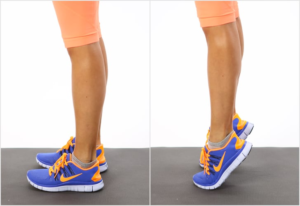 Preparation: Stand upright, feet parallel, shoulder width apart, knees pointing forward and in-line with the big toe. Heels flat on the floor. Arms extended forward for support. Core engaged, lower back arch maintained, look straight ahead.
Preparation: Stand upright, feet parallel, shoulder width apart, knees pointing forward and in-line with the big toe. Heels flat on the floor. Arms extended forward for support. Core engaged, lower back arch maintained, look straight ahead.
Execution: Raise heels off the floor by extending the ankles as high as possible, return to the starting position. Exhale moving up, on exertion. Inhale moving down.
Comments: Keep knees straight throughout the exercise. Weight distribution over the big toes. Maintain a steady pace through both the downward and upward phase of the movement. (No momentum)
Toe Raise
 Preparation: Stand upright, feet parallel, shoulder width apart, knees pointing forward and in-line with the big toe. Heels flat on the floor. Arms extended forward for support. Core engaged, lower back arch maintained, look straight ahead.
Preparation: Stand upright, feet parallel, shoulder width apart, knees pointing forward and in-line with the big toe. Heels flat on the floor. Arms extended forward for support. Core engaged, lower back arch maintained, look straight ahead.
Execution: Lift the toes, flex your feet off the floor while keeping the heels on the floor and the knees straight. Hold for a count of 5. Lower the toes. Exhale moving up, inhale moving down.
Comments: Keep chest up, shoulders retracted, don’t lean back. Maintain a steady pace through both the downward and upward phase of the movement. (No momentum).
Lateral Shoulder Raise
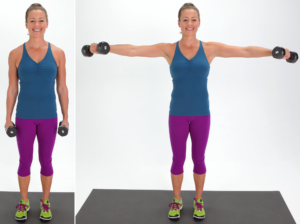 Preparation: Stand upright, feet parallel, shoulder width apart. Core engaged, knees not locked. Arms to the side.
Preparation: Stand upright, feet parallel, shoulder width apart. Core engaged, knees not locked. Arms to the side.
Execution: Raise arms laterally to approximately shoulder level, and then lower to original position. Exhale moving up, on exertion. Inhale moving down.
Comments: Keep arms straight and neck relaxed. Trunk should stay stationary throughout the movement. Maintain a steady pace through the downward and upward phase of the movement. (No momentum).
Front Shoulder Raise
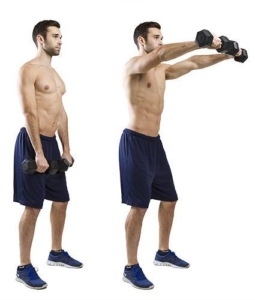 Preparation: Stand upright, feet parallel, shoulder width apart. Core engaged, knees not locked. Arms in front of the thighs.
Preparation: Stand upright, feet parallel, shoulder width apart. Core engaged, knees not locked. Arms in front of the thighs.
Execution: Raise arms forward to approximately shoulder level, and then lower to original position. Exhale moving up, on exertion. Inhale moving down.
Comments: Keep arms straight and the neck relaxed. Trunk should stay stationary throughout the movement. Maintain a steady pace through the downward and upward phase of the movement. (No momentum)
High Plank
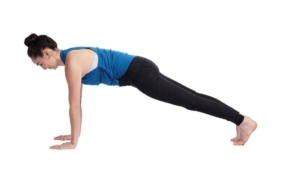 Preparation: Assume a high plank position, hands on the floor underneath your chest, feet flexed in line with the hips. Squeeze your thighs and glutes for stability. Engage your core.
Preparation: Assume a high plank position, hands on the floor underneath your chest, feet flexed in line with the hips. Squeeze your thighs and glutes for stability. Engage your core.
Execution: Maintain this isometric position for a defined period of time, while breathing regularly.
Comments: Both upper and lower body must be kept straight throughout the exercise. Keep your head and neck neutral.
Forearm Plank
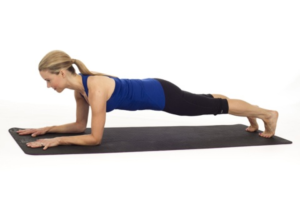 Preparation: Lie down on your stomach. Place forearms on the floor with elbows below shoulders and arms parallel to your body at about shoulder width. Feet hip width apart. Stabilize yourself on your forearms and toes. Maintain regular breathing.
Preparation: Lie down on your stomach. Place forearms on the floor with elbows below shoulders and arms parallel to your body at about shoulder width. Feet hip width apart. Stabilize yourself on your forearms and toes. Maintain regular breathing.
Execution: Drive your forearms into the floor, gradually tighten your quads, glutes and core.
Raise your body parallel to the floor. Keep your core engaged.
Comments: Both upper and lower body must be kept straight throughout the exercise. Keep your head and neck neutral.